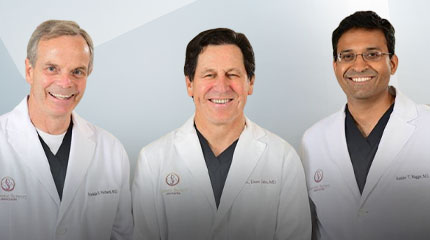Skin Laxity and How it Changes Over Time
Conveniently located to serve the areas of Maryland, Virginia and Washington, D.C.
Posted on June 20, 2019 under Medical Spa
Skin laxity is an essential topic when it comes to treating the signs of aging. Skin laxity or the loss of skin elasticity can be tied to a huge number of aging symptoms. Wrinkles, deep lines, sagging skin and lost volume all have something to do with skin laxity. Fortunately, skin laxity can be treated.
At Cosmetic Surgery Associates, we recognize the issue of skin laxity and how it impacts your appearance. Combining our many decades of experience and training with the world’s most advanced skin rejuvenating technologies allows us to address all manners of aging symptoms and tackle the issue of skin laxity and its impact on your appearance.
Contact us to learn more about our surgical and non-surgical skin rejuvenation and anti-aging treatments.
What is Skin Laxity?
Skin laxity occurs as a result of lost skin elasticity. Your skin’s elasticity enables it to bounce back from stretching, hold a taut form to your body and resist the effects of gravity. Skin laxity varies from individual to individual with some naturally possessing more elastic skin than others.
Healthy, youthful, and vibrant skin is something we’re each born with naturally, but as time passes, a variety of factors degrade the quality of the skin. One of these issues is the loss of collagen and elastin in the skin, which leads to loss of skin elasticity.
Collagen and Elastin
Collagen and elastin are proteins that play a vital role in supporting skin structure and health. Studies have strongly established collagen’s importance in promoting skin health.
Although daily skin maintenance is essential, the eventual effect of time and aging can take its toll on your skin’s elasticity, resulting is sagging, wrinkling, and stretching. Aging results in less elastin and collagen produced in our skin. Additionally, lifestyle habits such as smoking, stress, and overexposure to the sun accelerate the breakdown of skin elasticity.
 With sun exposure, harmful UV rays penetrate the skin and trigger photoaging. Numerous dermatological studies have shown that those who are prone to sun exposure will typically experience accelerated rates of photoaging. If you are regularly exposed to the sun without adequate sun protection, the sun’s UV rays are chronically triggering the release of free radicals and oxidative molecules in your skin. These oxidative elements set in motion chemical reactions that weaken the molecular structure of skin cells. Some studies are indicating that as much as 50% of aging symptoms are caused by the sun!
With sun exposure, harmful UV rays penetrate the skin and trigger photoaging. Numerous dermatological studies have shown that those who are prone to sun exposure will typically experience accelerated rates of photoaging. If you are regularly exposed to the sun without adequate sun protection, the sun’s UV rays are chronically triggering the release of free radicals and oxidative molecules in your skin. These oxidative elements set in motion chemical reactions that weaken the molecular structure of skin cells. Some studies are indicating that as much as 50% of aging symptoms are caused by the sun!
The oxidative stress on your skin triggered by the sun breaks down your skin’s supportive structures and results in loss of skin elasticity. Moreover, oxidative stress breaks down your skin’s natural protective characteristics and ability to retain moisture.
How is Skin Laxity linked to Aging?
Over time, skin laxity worsens and is linked to the appearance of bands of sagging skin, jowls on the face, depressions in the cheeks and many other symptoms of aging. Simply put, your skin is losing its ability to resist the force of gravity and retain shape along your natural features.
Fluctuations in weight, pregnancy, or other general changes in body shape can stretch your skin as well, creating loose drapes of sagging skin. Sharper features, hollow cheeks, and sunken areas of your face are hallmarks of skin laxity.
How Can I Tell if I Have Good Skin Elasticity?
The “pinch test” is a quick and easy way to measure your skin elasticity.
Step 1: Rest your hand palm down and with your other hand, pinch the skin on the back of your hand, holding for at least five seconds.
Step 2: Release your pinch and count how many seconds it takes for your skin to flatten.
See the chart below for how your skin elasticity measures up with those in your age group:
Ages under 30: 1-2 seconds
Ages 30 – 44: 3-4 seconds
Ages 45 – 50: 5-9 seconds
Ages over 60: 10-15 seconds
Ages over 70: 35-55 seconds
If you are unsatisfied with the time it takes your skin to bounce back, you may have skin laxity. Fortunately, there are many options to help you tighten your skin and combat the onset of aging symptoms.
What Can I Do to Treat or Prevent Skin Laxity?
Although time inevitably causes some signs of aging, advancements in aesthetic technologies and cosmetic techniques give us many tools to combat aging.
At Cosmetic Surgery Associates, we are industry leaders in treating symptoms of aging caused by skin laxity. From small blemishes to large deposits of sagging skin, there are solutions that provide safe, long-term results.
Surgical Procedures
If your goal is to turn back the clock on your appearance as much as five to ten years, you may be more interested in surgical treatments.
 Facelift: is the go-to solution for significant sagging, drooping and jowling on the face. This is a surgical procedure where excess skin is removed from behind the temples and the thin layer of muscle called the SMAS layer is lifted. Overall facial features are lifted and tightened for a younger look that is natural to your facial structure.
Facelift: is the go-to solution for significant sagging, drooping and jowling on the face. This is a surgical procedure where excess skin is removed from behind the temples and the thin layer of muscle called the SMAS layer is lifted. Overall facial features are lifted and tightened for a younger look that is natural to your facial structure.
Tummy Tuck: Stretched skin that has collected on the abdomen can happen as a result of skin laxity or as a result of weight loss or pregnancy. The abdominal “pouch” can be removed to achieve a flatter, taut abdomen through a tummy tuck. The tummy tuck, also known as the abdominoplasty, is also a safe, effective treatment for weakened or herniated abdominal muscles.
The tummy tuck is performed by surgically removed excess, stretched skin from the lower abdomen and repositioning the belly button to a natural location. Stretch marks on the lower abdomen may also be removed or are well-hidden in this process.
Breast Lift: Skin laxity can have a significant impact on the appearance and position of breasts. Many women experience significant sagging and wish to achieve lifted rejuvenated breasts. The breast lift is perfectly suited for restoring a youthful appearance to breasts that are sagging due to aging, skin laxity and changes from pregnancy.
Non-Surgical Procedures
With subtler signs of aging such as fine lines, wrinkles and early traces of skin laxity, there are no-surgical anti-aging procedures. These treatments are ideal for those who also prefer to avoid surgery or simply do not have the time for an extensive recovery period.
 Dermal Injections: Dermal injections come in two main forms: fillers and relaxers. Examples of fillers are Juvéderm and Restylane, which are well-suited for adding volume to sunken areas and filling deep creases such as nasolabial folds. Relaxers are treatments such as Botox, which reduces chronic facial muscle contractions that create wrinkles over time. Dermal injections are generally quick treatments lasting about fifteen minutes to half an hour.
Dermal Injections: Dermal injections come in two main forms: fillers and relaxers. Examples of fillers are Juvéderm and Restylane, which are well-suited for adding volume to sunken areas and filling deep creases such as nasolabial folds. Relaxers are treatments such as Botox, which reduces chronic facial muscle contractions that create wrinkles over time. Dermal injections are generally quick treatments lasting about fifteen minutes to half an hour.
Microneedling: Microneedling kicks your skin’s natural healing powers into high gear for a rejuvenated complexion and tighter skin. This treatment takes as little as half an hour with little downtime.
Microneedling also triggers fresh collagen production for long-term restoration of skin elasticity.
Consultation
 The effects of loss of skin elasticity effect every individual differently and the best options for one person may not be the best fit for another. Schedule your consultation with the Cosmetic Surgery Associates and we can guide you to the treatment that will give you results that you will love.
The effects of loss of skin elasticity effect every individual differently and the best options for one person may not be the best fit for another. Schedule your consultation with the Cosmetic Surgery Associates and we can guide you to the treatment that will give you results that you will love.
Every consultation is a highly personalized and private meeting between you and one of our specialists where you can discuss your goals point out which areas concern you. Together, Dr. Richards, Dr. Jabs, and Dr. Magge have decades of experience and are consistently one of the top-ranked plastic surgeons.
Cost of Treatment
Our philosophy at Cosmetic Surgery Associates is to provide tailored treatments because our experience has shown that consistently delivers the best results. The cost of treatment is determined after a consultation where one of our Doctors can make a detailed assessment of your goals and case to create a customized treatment package.
Our Plastic Surgery Associates team includes Dr. Franklin Richards, Dr. A. Dean Jabs, and Dr. Keshav Magge. Each of our plastic surgeons is board-certified, and together they have over 60 years of combined experience. Drs. Richards, Jabs, and Magge are all highly qualified in procedures for the face, breast, and body, and pride themselves in providing excellent results through our state-of-the-art, Quad A certified operating centers






